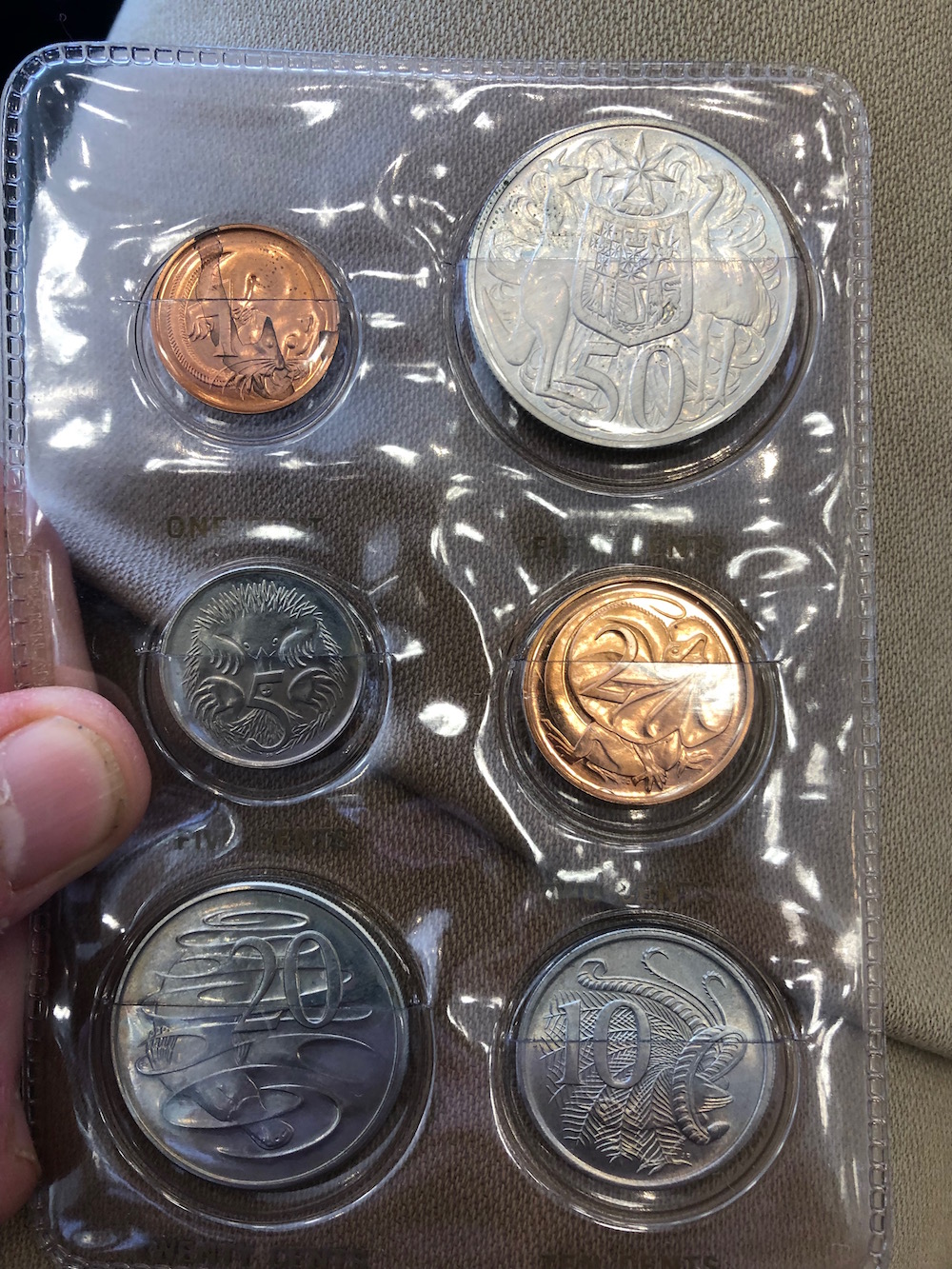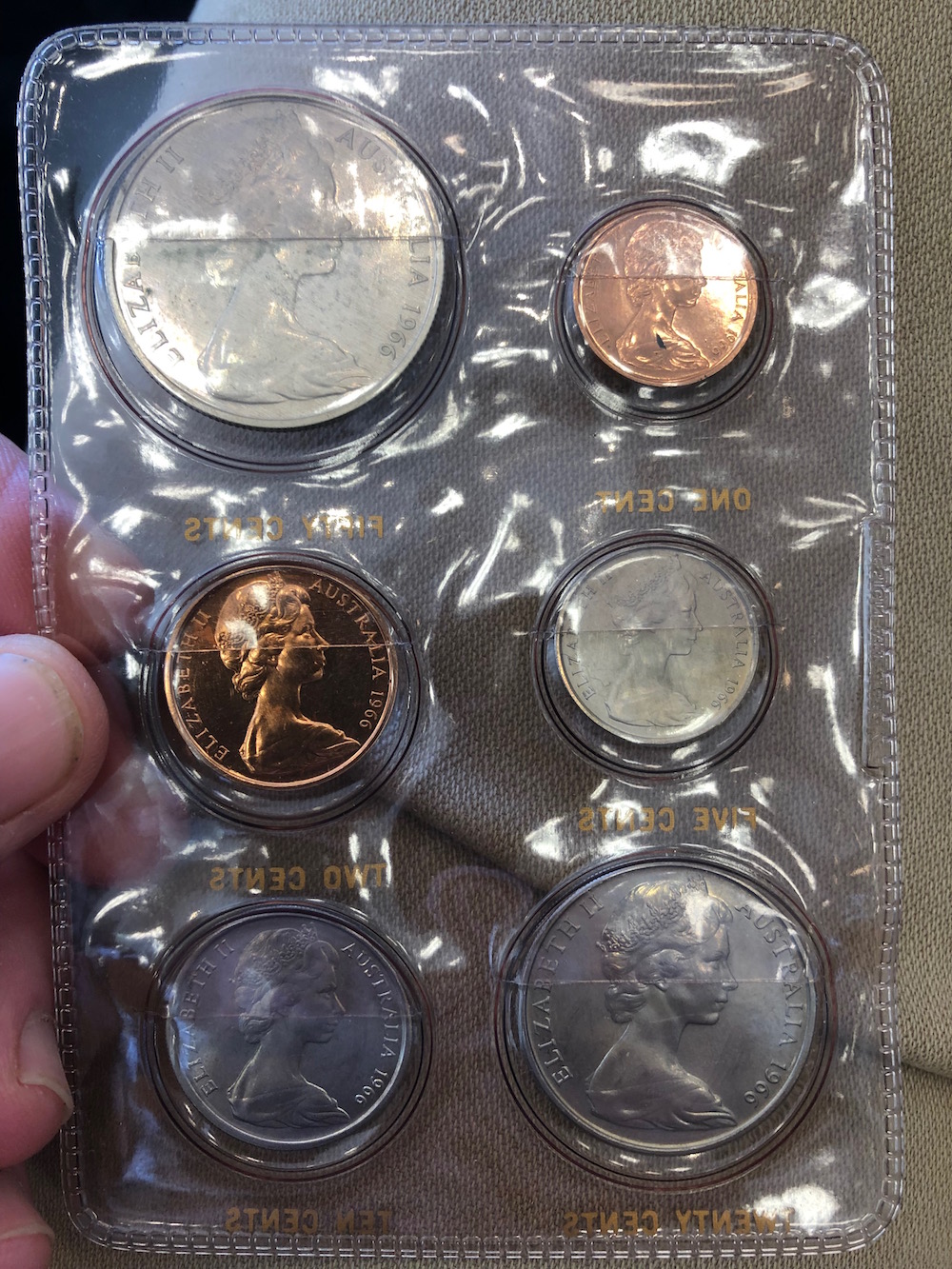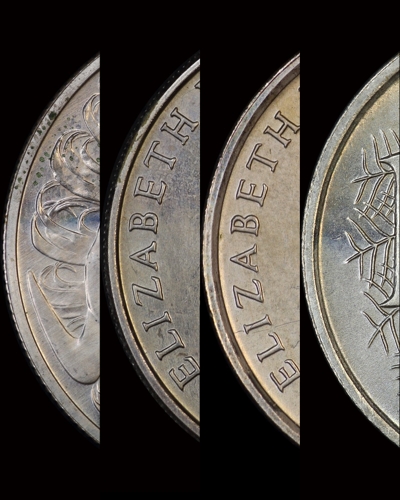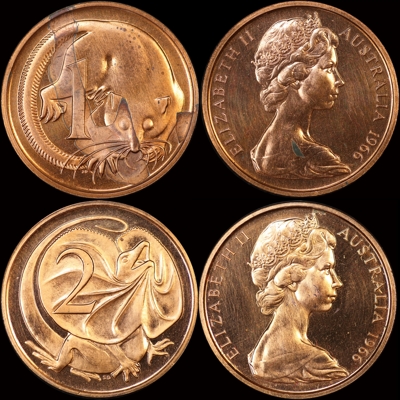A Non-Binary 1966 VIP Uncirculated Coin Set - Specimen Strikes Included

While attending a local coin, stamp and note show in Perth, I spotted a 1966 VIP Uncirculated decimal coin set on the table of another dealer. I’ve handled several of these sets, and regard them as a truly scarce memento of a major event in Australia’s economic history - one that often has a unique social history if the provenance is known.
The vendor advised that he’d acquired the set out of South Africa, and although the provenance sounded exotic, it didn’t seem to be particularly relevant at the time. I bought the set and put it aside with out other new inventory.
When I had time to sit down and examine the set in detail later in the week, I could see it didn’t match the look of the other VIP sets I’d handled. The most startling difference was that the one cent coin had what looked like a planchet error right across the reverse.
A planchet error like that is unusual enough on any decimal coin, but for it to be seen on a set of coins that were apparently presented to a VIP really was eye-catching. Aside from the lamination error, the surfaces of the copper coins were quite glossy (in contrast to the dusty surfaces normally seen on our early decimal copper coins), while the 50¢ had a satin look to it - quite different to the standard white frosty appearance that the 1966 silver 50c struck for circulation have.
Determining whether the coins were indeed different and not just in the eye of this beholder has been an interesting journey, as has the path to learning the reasons behind them.
A Cause for Widespread Celebration
Australia’s switch to a decimal currency in 1966 was a cause for widespread celebration - not only did the nation now have coins and notes that featured uniquely Australian designs, but the government had also successfully planned and executed one of the largest national infrastructure projects undertaken since the Second World War.
One of the ways Commonwealth Government officials demonstrated their pride was by presenting sets of the new coins as diplomatic gifts to influential dignitaries that were either visiting Australia or were being visited overseas.
1,000 special “VIP” wallets were produced by Admiral Plastics solely for this purpose - the colour of the vinyl used for the outer sleeve was different to those that were sold to collectors; the printed text on the front of the wallet was also different, as was the configuration of the clear plastic sleeve that contained the coins. The wallets were stored in a locked cupboard within the Mint, access to them was restricted to only the most senior RAM staff.
RAM records show that only 520 of the 1,000 wallets prepared were actually issued, the remaining 480 (empty) wallets were destroyed under supervision.
A former RAM staff member who was responsible for the preparation of the VIP sets advised that when a VIP set was required, RAM staff removed coins from one of the standard green and white "poly-pack" carded mint sets, and inserted the coins into one of the empty VIP wallets.
The above description of this process indicates that officially, only standard circulation-strike coins were ever included in the VIP presentation sets.
Two Production Runs Only - Proof and Circulation

Existing numismatic literature identifies only two production runs of 1966-dated decimal coinage - proof strikes and circulation strikes.
The only 1966-dated Australian coins sighted to date that exhibit technical characteristics different to the coins struck either for circulation or inclusion in proof sets have been a very small number of patterns or specimens struck for trial or sample purposes. A very small number of those specimens or patterns are held by public institutions in Australia, even fewer have been sighted in private hands.
Characteristics That Set Them Apart
A detailed physical examination of the coins in the VIP set ex South Africa indicates that several of them exhibit characteristics that set them apart from known proof and circulation strikes. Those characteristics are listed in the table below:
| Obverse | Reverse | Mint | Diameter | Weight | Rims | Surfaces | |
| 50c | No eyelash | Double bars partially visible | Canberra | 31.57 | 13.41g | Square and sharp | Glossy and reflective under a dusty patina |
| 20c | 2 eyelashes | Gap | Canberra | 28.61 | 11.24g | Standard for circulation strike | Glossy and reflective under a dusty patina |
| 10c | 1 eyelash | Extra spur | London | 23.78 | 5.61g | Slight bevel to sections of the reverse | Standard for circulation strike |
| 5c | 1 eyelash | Short spine | Canberra | 19.45 | 2.93g | Sharp and bevelled | Glossy and reflective under a dusty patina |
| 2c | 1 eyelash | Sharp claws | Canberra | 21.69 | 5.21g | Flat and square | Glossy and lustrous, they appear to have been lacquered |
| 1c | 1 eyelash | Sharp whiskers | Canberra | 17.50 | 2.54g | Flat and square | Glossy and lustrous, they appear to have been lacquered. Two major sections of the reverse appear to have been affected by a lamination peel |
Based on the above characteristics, it appears these coins could have been struck as specimens, rather than as proofs or circulation strikes.

We have lodged requests for information about any specimen coins dated 1966 held by the Royal Australian Mint, the Royal Mint Museum in Wales and the Museum of Victoria. Images of a set of 1966 coins presented to Harold Holt, who was the Commonwealth Treasurer in 1966 and now on display at the Museum of Australian Democracy in Canberra indicate they should be examined also.
It will be interesting to compare the specifications of these coins with those held in the 4 public collections mentioned above and to learn just when, where and why they were struck.
Giving Samples to Other Mints or Museums or to Private Individuals
If the coins in this set are indeed attributed as being specimen strikes, questions arise - where, when and why were they struck, and how did they come to be distributed? Standard procedure for the VIP sets was for coins from the standard “poly-pack” mint sets to be included, however we understand that as James Miller Henderson was one of the two RAM staff with access to the cupboard that contained the VIP folders, it is not beyond reason to accept that some or all of the coins may have been sourced from somewhere other than one of the “poly-pack” sets.
Some context can be found in “Heads I Win”, a book that covers the career of David Allan Gee, a man regarded by many as Australia’s most notorious coin forger.
As strange as it may seem, Henderson not only knew Gee but had both a professional and personal relationship with him. Gee was prosecuted for a range of crimes relating to numismatics in the late 1970’s, it was in the course of that case that the liberties Henderson took with the Mint’s most coveted products were revealed: “In response to a question from David Rofe, leading for the Crown, Henderson said that he had always believed that as Controller of the Mint he had the authority to give samples of coins to "other mints or museums, or to private individuals who had given some assistance to the Mint. Gee was one of these individuals." Henderson added: " Mr Gee is an expert. I valued his advice and help."
Part of the case against Gee was that he had possession of several Australian 50¢ patterns, somehow as a result of his relationship with Henderson. The Commonwealth chose not to proceed with a case of theft against Henderson for illegally removing the patterns from the Mint and distributing them. Perhaps as a result, Gee was not found guilty on charges of receiving them either.
The above passage clearly demonstrates that Henderson distributed “samples” to people outside the Mint when he deemed it appropriate to do so, and that his distribution was not always conducted under formal particular oversight by other RAM staff.
Lacquered Surfaces - Normally Unseen In Australia
 Collectors of Australian coins are aware that the vast majority of the early decimal copper coins that remain in existence tone very easily, particularly when still in mint-state quality. It was not standard practice for RAM staff to lacquer any of their products after they were struck until at least 1969.
Collectors of Australian coins are aware that the vast majority of the early decimal copper coins that remain in existence tone very easily, particularly when still in mint-state quality. It was not standard practice for RAM staff to lacquer any of their products after they were struck until at least 1969.
Collectors of proof and specimen coins from South Africa are well aware however that lacquering of proof, specimen or even circulation-strike coins was common practice there for many decades. Although it is not known whether South African coins were lacquered by Mint staff shortly after the coins were struck, or if they were personally lacquered by the collectors after purchasing them, it is agreed that it is not unusual to see 20th century South African proof coins that have been lacquered.
Examination of the reverse of the 1c in this VIP set shows that the difference in colour across the reverse is not due to a lamination peel of the planchet - the fine detail in that section of the coin has been struck to the same quality as the remainder of that side of the coin.
Small sections of the edges of both the 1c and the 2c show extra clear laminate beyond the straight edge of the coin. This explains the inequality of colour on the reverse, it is due to the mis-application of laminate, rather than due to an error in the planchet.
The Canberra - South Africa Connection
I am advised that Henderson had a strong relationship with the Governor of South Africa, and further that the Master of the South African Mint visited Canberra in the months that followed the introduction of decimal currency to Australia. These two links between Henderson and South Africa may well explain how this VIP set came to contain coins struck to specimen standard, rather than circulation-quality coins.
The Royal Mint Museum Collection
Email enquiries with the curators of the Royal Mint Museum collection took some time to run to ground, and unfortunately didn’t yield the level of technical detail that I was hoping to get. The staff member I corresponded with advised that the Royal Mint Museum holds 54 Australian coins dated 1966 - one described as a pattern without a denomination; 19 * 50¢; 3 * 20¢; 13 * 10¢ (including several struck in silver and one in bronze); 3 * 5¢; 6 * 2¢ and 9 * 1¢. Technical details such as the mint of origin; strike type and design characteristics have not yet been recorded, so it isn’t yet clear whether these coins are examples of those struck by the Royal Mint for Australia, or whether they are samples of work sent back to the UK by the Royal Australian Mint.
The National Coin Collection - Royal Australian Mint
I’ve also had some correspondence with the RAM staff accountable for the National Coin Collection, held by the Royal Australian Mint. They are currently reviewing production records from that era to identify an empirical explanation for the existence of non-binary coins such those included in this set
Although it’s frustrating not to have definitive answers about the attribution of the coins in this set yet, it is proving to be an interesting avenue of research. All future results will be added as they become available, if you have any additional information that might be useful, I’ll be happy to add it to the data we already have.